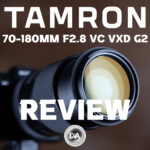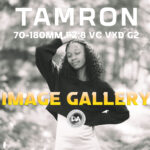
Tamron 28-300mm F4-7.1 VC VXD Review
Tamron has long been a company invested in designing all-in-one/superzoom lenses. My very first Tamron lens was their 18-270mm PZD lens, which I owned and used for a few years starting in 2010. That was an APS-C lens, but Tamron later branched into full frame all-in-one lenses like the 28-300mm PZD lens that I reviewed in 2014. These types of lenses tend to be commercially successful because there is a good percentage of people who want the improved image quality of a “professional” camera but don’t want to be constantly changing lenses or carrying multiple lenses. The idea of one lens that does everything is very appealing to them, a sort of “kit lens on steroids” with a much more robust zoom range on the telephoto end. The secondary market for a lens like this are those who want a single lens solution for travel. I own the Tamron 28-200mm RXD lens for that latter reason, and I’ve both given it a positive review (in 2020) and more recently explored if it could handle the 61MP resolution of the Sony a7RV while traveling here. I really like the 28-200mm, but there will always be those who want more reach, and that’s why the Tamron 28-300mm F4-7.1 Di III VC VXD now exists. Is a bigger zoom better? Find out in my video review shared below or read on in the text review today.
Follow Me @ YouTube | Patreon | Instagram | Facebook | DA Merchandise | Flickr | 500px | X
Thanks to Tamron USA for sending me a review loaner of this lens. As always, this is a completely independent review. *The tests and most of the photos that I share as a part of my review cycle have been done with the Sony a7RV along with the Sony Alpha 1 that serve as my benchmark cameras for Sony lenses.
__________________________________________________________________________________________________
Here’s a look at the overall selling features of the new 28-300mm VXD, or what Tamron codes the A074:
- Full-Frame | f/4-7.1 to f/22-40
- VXD Linear Motor Focus Mechanism
- VC Camera Shake Reduction System
- Focus Set Button, Zoom Lock Switch
- Minimum Focusing Distance: 7.5″
- 20 Elements in 13 Groups
- 9-Bladed Diaphragm
- Moisture-Sealed Design, Fluorine Coating
- Tamron Lens Utility Connector Port
But probably the biggest feature here is the incredible zoom range that is a full 10.7x, going from this framing at 28mm:

…all the way to this framing at 300mm:

That’s obviously going to be both incredibly useful and incredibly appealing, particularly if the image quality doesn’t suffer too much. All superzoom lenses are a serious of compromises, as the engineers have to try to solve the problems of wide angle focal lengths while also having to cope with the inherent problems of telephoto focal lengths. Part of what has made the Tamron 28-200mm so popular is how good the image quality is despite having a fairly big zoom ratio.
One of the main limitations of the new 28-300mm VXD relative to the popular 28-200mm RXD lens is the fact that this lens is very SLOW when it comes to its aperture. It is a variable aperture lens that runs from F4 on the wide end to F7.1 on the telephoto end, but it’s worse than that. It actually closes down very quickly. Here’s a look at the aperture values relative to the focal lengths:
- F4 (28-31mm)
- F4.5 (32-43mm)
- F5 (44-53mm)
- F5.6 (54-77mm)
- F6.3 (78-169mm)
- F7.1 (170-300mm)
Ouch! That means of the 272mm of zoom range represented here, 223mm of it is at F6.3 or slower, and only 49mm are at F5.6 or faster. By contrast, here is the breakdown on the 28-200mm:
- F2.8 (28-49mm)
- F3.5 (50-99mm)
- F4.5 (100-149mm)
- F5.6 (150-200mm)
The 28-200mm is a radically brighter lens by comparison all throughout the zoom range, and frankly this was this issue with the 28-300mm VXD that I found most frustrating during my review period. This is a lens that vastly prefers being used in good light, but if you can get that good light, you can also get good images.

So is that incredible zoom range worth the tradeoffs to light gathering? Let’s dig a little deeper and find out.
Tamron 28-300mm VXD Build and Handling
Tamron tends towards overly descriptive names for their lenses. In this case we have the Tamron 28-300mm F4-7.1 Di III VC VXD, which I suspect you’ll agree is a bit of a mouthful. We’ve talked about zoom and aperture range already, so here’s what the rest means.
- Di III = Designed for Mirrorless
- VC = Vibration Compensation, or Tamron’s lens based image stabilization
- VXD = Voice-coil eXtreme-torque Drive (the Linear autofocus motor)
I think the Di-III designation is becoming increasingly meaningless for the simple reason that essentially all current lens design is on mirrorless, with DSLRs seeming to be done at this point.
One of the selling features of the 28-300mm VXD is that it has such a moderate size for such a big zoom range. It is larger and heavier than the 28-200mm, but, as you can see, it’s not by much.

The 28-200mm is 74 x 116.8 mm and weighs 576g, while the 28-300mm VXD is 77mm in diameter (3″) x 126 mm (5″) in length and weighs 610g (1.3lb). That’s just 34g heavier. This is one of the big reasons for the slower maximum aperture, as not only does it make the lens a little easier to engineer but also allowed those same engineers to keep the size down.

This is still a lens that will fit fair easily into most bags standing upright.
You may have also noticed that the new lens is much more attractive than the old lens. In 2020, Tamron was still sailing with the philosophy of producing simple lenses with few features but rather a focus on performance instead. It was more about what was inside the lens rather than what showed up on the outside. While Tamron has continued to develop even better optics and autofocus motors, they have changed their philosophy to modernize and improve their lens design. The newer designs (like the 28-300mm VXD) are more sculpted, have a nicer finish, and are more feature rich. The 28-200mm didn’t have any switches or buttons, but just a zoom lock button on the side to prevent zoom creep. The 28-300mm VXD includes a zoom lock but adds several other features as well.

On the left side of the lens you will now find a focus set/function button. The function of this button can be set in the camera or through Tamron’s free Lens Utility software. It is available from the Android app store or you can visit this page to download the software and/or get more information:

There are a variety of functions that can be set in the software itself, everything from a preset focus position to switching between AF/MF to even establishing a proper Astro/infinity focus point. The nice thing about being able to use the Lens Utility function to assign this value is that you can program a function specific to this particular lens rather than using the default value from the camera. This lens has no AF/MF switch, for example, and that happens to be one of the choices that I could set the button to accomplish.

You also have a little more control over how you interact with the button. You can choose for it to respond at just a tap or for it have to be held down for a second before activating. That could prevent inadvertent bumps (if that proves to be an issue for you). You access the Lens Utility software on a computer or Android device by connect the computer/mobile device to the weathersealed USB-C port on the lens barrel.

In the program you can also control the behavior of the focus ring and do firmware updates.



I wouldn’t call the lens “feature rich” by modern standards, but there is certainly far more customization and control than what was found on the 28-200mm lens.
Also present on the barrel is two rings. The closer narrower of the two is the focus ring. It is raised from the lens barrel a bit (rather than flush like the 28-200mm’s ring), making it more ergonomic and visually pleasing. Manual focus emulation is quite good, and the quality damping gives the impression of being a real manual focus experience. The addition of the USB-C port means that that you also have more control over the behavior of the focus ring. This includes being able to control the rotation of the ring and to choose whether the focus action is linear or non-linear (speed sensitive) in behavior. This adds to the value of the ring.

The second ring is the zoom ring and it is near the front of the lens. It is very wide and has defined ribs on it. That portion of the barrel scallops out a bit, which helps the hand to fall more naturally to it. Focus action is fairly smooth, though I do find that there is just a little more force required in the middle of the zoom range.

There is a double extension of the inner barrel during zoom action, as the inner barrel extends about 77mm during zoom. That fairly dramatically increases the length of the lens and also widens the length difference between it and the 28-200mm.



Tamron has included a nicely made, fairly shallow lens hood. The front filter size is the extremely common 67mm standard that is shared across the vast majority of Tamron’s mirrorless lenses.

Tamron has really been nailing weather sealing, and that’s definitely the case here. There’s a rubber gasket at the lens mount that suggests at the weather sealing inside, and Tamron also shows a total of 11 other internal seal points along with a fluorine coating on the front element to give further protection. A fluorine coating not only helps protect the front element from scratches but also makes it water and fingerprint resistant and thus easier to clean. This is a professional grade lens ready for professional use.

The 28-300mm VXD does differentiate from the 28-200mm by including Tamron’s VC, or Vibration Compensation. There was a time when I found Tamron’s VC to be the best image stabilization out there, but it’s been some time since I’ve been thoroughly impressed by VC on any new lens. It’s as if they can’t really find a way to design VC that is fully compatible with the on-board IBIS in Sony’s camera. You don’t have any way to turn either individual system off, so it is always both VC and IBIS on or off. I’m sure the VC helps, but I don’t find the lens to feel any more stable than, say, the non-stabilized 70-300mm RXD lens from Tamron. I find it telling that Tamron gives no CIPA rating for the VC, as I suspect that means that it wouldn’t be that high. I definitely got some shaky results at shutter speeds (1/80th of a second), which surprised me. I had to work pretty hard to get steady results even at 1/15th of a second, getting only fully steady results in about one out of six shots.

Tamron’s recent trends regarding MFD (minimum focus distance) hold true here, as the lens sports two different MFDs for wide (0.19m/7.5″) and telephoto (0.95m/39″). You can get to nearly 0.36x magnification on the wide end (1:2.8) and 0.26x (1:3.8) on the telephoto end. Those figures are both useful, though I will note that you have to get extremely close to your subject on the wide end, making it much harder to pull off without shading your subject.



I find the telephoto end a little easier to use because of having more working room.
Tamron has nine rounded blades in the aperture iris, and they claim that the aperture iris will stay circular for at least two stops down from maximum aperture. That seems accurate to me. Wide open you’ll definitely see a lot of geometric deformation towards the edge of the frame.

Stopped down the lens will produce an okay but not particularly distinct sunstar.

Tamron’s more recent lenses have had a more upscale build and feature list, but, to Tamron’s credit, they’ve also managed to keep pricing under control. The price for the now four year old 28-200mm RXD? $799 USD. The price for the new, more feature rich lens with the bigger zoom range? $899 USD. The Sony 24-240mm F3.5-6.3 OSS lens (with fewer features and worse performance) costs $1048 USD, so I think that Tamron has found a way to keep this lens appealing and a relative value.

Autofocus and Video
Tamron has given the 28-300mm VXD their premium focus system, the Voice-coil eXtreme-torque Drive (VXD), which is a high end linear focus motor.

The big knock on many all-in-one zooms (including some of Tamron’s own in the past), is that focus speed really slows down when you get to the telephoto end. The only way to solve that problem is by introducing a high powered autofocus system into the equation. I found that focus was fast enough to capture birds in flight without much issue.

In my standard focus tests I found that speed was very quick whether shooting at the wide or telephoto end of the zoom range. I was able to get a few decent BIF (bee in flight, of course!) shots where focus was quick enough to snap onto the fast moving bees.

The nature of this lens and its slow maximum apertures means that you will be shooting in a lot of “dim” lighting conditions. Autofocus often won’t have a lot of light to work with. That creates other problems, but fortunately the speed and accuracy of the autofocus system does at least help that aspect to not be a problem. I took this lens as a sole lens to an event, and while I hated shooting at the slow aperture values (and being stuck at ISO 6400 and 12,800), the 28-300mm VXD had no problem focusing in that setting.

Eye detect worked fine in my tests, both formal and practical. I got effective focus on human, animal, and insect subjects.


Here’s another:

The bottom line is that AF for stills was pretty effortless. Tamron’s VXD is a very good focus motor, and it definitely helps AF prove a strength for the 28-300mm.

Video AF is likewise excellent. When I tested focus pulls, they were snappy and confident. No settling or pulsing. Focus breathing is going to vary according to focal length, but I found it pretty good even at telephoto focal lengths.
My “hand test” where I alternately block the camera’s view with my hand and then remove the obstruction of my hand also went well. The camera moved easily from my face to my hand and vice versa. The focus change isn’t incredibly obvious due to the smaller maximum aperture, thus depth of field doesn’t change a lot.
I zoomed in and out during video capture, and didn’t see any warping and only minimal refocusing. d.

Overall the Tamron 28-300mm VXD is a very good focusing lens. I would say that focus quality is pretty much first party level; I’d definitely take it over the Sony 24-240mm.
Image Quality Breakdown
Big zoom ratios like this tend towards complex optical designs, as engineers have to try to keep a reasonable level of performance across a big zoom range. That complexity ramps up even more when you’re talking about a full frame design. So, as expected, the optical design for the 28-300mm VXD is very complex, with 20 elements in 13 groups. The MTF chart at 28mm shows good center and midframe performance, but with a marked decline into the corners. At 300mm the center is actually considerably sharper, with a similar performance in the midframe and slightly better corner performance. Not bad, really, for such a huge zoom ratio.


And, at its best, the 28-300mm VXD can produce nicely detailed images.

There are always some compromises in these types of designs, but hopefully Tamron has managed to mitigate those.
We’ll dive into the technical side of things first with a look at vignette and distortion at 28mm F4:

Predictably we have fair amount of barrel distortion (a +10 to correct) and a moderately heavy amount of vignette (a +62 to correct). That’s slightly over 2 stops of vignette. Both figures are significant but not bad. Both are easily correctable, and while the distortion isn’t 100% linear, it really doesn’t have much of a mustache pattern for this type of lens. This is actually pretty good for the wide end of a lens like this.
As you progress through the zoom range the distortion pattern changes (predictably) to a pincushion style distortion (test done at 275mm for the sake of space in my test area).

Again, however, its not severe. I was able to correct the distortion with a -8 and get a very clean result. Vignette was lighter here at a +44 (about 1.5 stops).
I don’t see a lot to complain about here. I have seen much, much worse results from many lenses with much lower zoom ratios.
LoCA (Longitudinal Chromatic Aberrations) present as a color fringing before and after the plane of focus. I saw good results at lower focal lengths but saw more pronounced fringing at 300mm. Real world LoCA wasn’t bad in most situations, however.



I looked for lateral chromatic aberrations (LaCA) near the edges of the frame, where it exhibits as fringing on either side of dark lines. I can see some mild LoCA at wide focal lengths, but nothing extreme.

Nothing much to complain about here. Tamron’s engineers have done a good job of mitigating some of the typical optical weaknesses of lenses like this.
Here’s my test chart that the crops will be taken from. Tests are done on a 61MP Sony a7RV and crops and comparisons are shown at 200% magnification.

Here’s a look at 28mm, F4 crops from the center, mid-frame, and bottom right corner:



Pretty much what the MTF chart suggested. Very good center and mid-frame results from wide open, but the corners fade very fast and look pretty mushy. That’s not just a “close distance” aberration due to the testing distances for test charts. Here’s the original image and crops from the middle and edge of the image shot at 28mm, F4 on my 50MP Alpha 1.



There’s great detail in the middle, but not so much in the corners. So does that improve if we stop the lens down?
The short answer is “not really”. Even stopped down to F8, the corners are still pretty soft.

This is a variable aperture zoom, as noted, and that affects both the maximum and minimum aperture. At 28mm, maximum aperture is F4 and minimum aperture is F22, but by 300mm the maximum aperture is F7.1 and the minimum aperture is F40. Regardless of which end of the spectrum you’re on, you can expect image quality to soften due to diffraction after F11.

By 50mm the center is very slightly less sharp, but the midframe is a tiny bit sharper and the corners look considerably better.

Stopping down a bit at 50mm will allow you to achieve pretty good sharpness all across the frame.

100mm is a little weaker, with a slighter softer image everywhere but the corners. Stopping down from F6.3 (maximum aperture) to F8 does make an obvious improvement to contrast.

The same trend is true at 200mm, where the lens isn’t particularly sharp at any point in the frame but is quite consistent overall. Stopping down to F8 does give a mild bump in contrast.

300mm is ever so slightly sharper than 200mm, though I doubt one could detect it outside of a side by side comparison at high magnification like what I did.

I’ve learned to temper my expectations on how sharp a lens like this can be, so I found that my expectations were reasonably met. An image like this at 300mm looks good at a normal viewing level:

…but less impressive when viewed at a pixel level.

As the MTF suggests, one axis (meridional) is a lot weaker than the other, so contrast isn’t amazing.
Part of what I’ve loved about the 28-200mm is that it routinely impresses me for being sharper than I expect lenses like this to me. The 28-300mm VXD, with its larger zoom range, is more in line with expectations. Image quality is fairly good, but not really great in any way.

That’s also true of the bokeh, which at times looks quite good.

This tends to be when using a long focal length fairly close, where compression can blur the background despite the aperture not being large.
That advantage gets lost at either shorter focal lengths or less advantageous distances, and that can result in a much busier background.

The reason for this is pretty simple; the Tamron 28-300mm VXD suffers from some rather pronounced outlining of the specular highlights.
You can see it in this shot, where the background looks a little busier because the outlining of defocus objects.

You can particularly see it in this series of screen shots from a video clip I have of the sun dancing off waves at the beach. I purposely defocused the image, and you can see that the specular highlights tend to look a bit harsh.



At the same time, I don’t want to oversell this, as what I’m demonstrating here is completely typical for this type of lens. Use the lens to its strengths, and it will reward you with pretty nice looking images!

Flare resistance isn’t perfect, but not bad for this type of lens. I saw some minor ghosting artifacts, but nothing significant.



So image quality is fairly good for this type of lens, but doesn’t quite reach the benchmark set by the 28-200mm RXD lens. Check out the image gallery link here for more photos.
Conclusion
The truth of the matter is numbers sell. Tamron already had an excellent 28-200mm RXD lens, which is, in fact, optically superior to this new lens. But I fully anticipate that many people will choose the new Tamron 28-300mm F4-7.1 VC VXD over the older lens. On paper it is the superior lens, with a bigger zoom range, the inclusion of VC and other features, and a better looking design, and the fact that you get an extra 100mm for only 100 extra bucks doesn’t hurt.

And that’s okay.
Different people have different needs, and some value (and understand) things like aperture more than others. The 28-300mm VXD happens to be a much better than average superzoom lens, but you need to be aware that you aren’t going to get G Master performance all throughout that big zoom range.

But I don’t want to discount what you do get, which includes an extremely useful focal range, an excellent build that includes thorough weather sealing and some useful features, and great autofocus. It is very rare in history that any superzoom lens could claim all of those features, which makes the Tamron 28-300mm F4-7.1 VC VXD a great value lens at just $899 USD.

Pros:
- Big, useful zoom range is the largest zoom ratio on Sony FF
- Beautiful build
- Useful features
- Thorough weather sealing
- Extremely fast autofocus
- Good focus accuracy
- Video AF works well
- Fairly well controlled distortion and vignette for superzoom
- Chromatic aberrations aren’t bad
- Reasonably sharp throughout zoom range
- Flare resistance is good
- Better value than Sony 24-240mm
Cons:
- VC doesn’t seem very effective
- Aperture range is very slow
- Corner sharpness on the wide end is weak
- Bokeh can get a little busy
- Not as sharp at the 28-200mm RXD
_________________________________________________________________________
GEAR USED:
Purchase the Tamron 28-300mm VXD @ B&H Photo | Adorama | Amazon | Camera Canada | Amazon Canada | Amazon UK | Amazon Germany
___________________________________________________________________
Purchase the Sony a7RV @ B&H Photo | Adorama | Amazon | Camera Canada | Sony Canada | Amazon Canada | Amazon UK | Amazon Germany
__________________________________________________________________
Purchase the Sony a7IV @ B&H Photo | Adorama | Amazon | Camera Canada | Sony Canada | Amazon Canada | Amazon UK | Amazon Germany
_________________________________________________________________
Purchase the Sony Alpha 1 @ Camera Canada | B&H Photo | Adorama | Amazon | Sony Canada | Amazon Canada | Amazon UK | Amazon Germany | Ebay
_________________________________________________________________
Want to support this channel? Use these affiliate links to shop at: B&H Photo | Amazon | Adorama | Camera Canada | Amazon Canada | Amazon UK | Ebay | Make a donation via Paypal
Buy DA Merchandise https://bit.ly/TWIMerch

Keywords: #withmytamron, Tamron, 28-300mm, Tamron 28-300mm Review, Tamron 28-300 Sony, Di III, VC, VXD, Travel, Tamron 28-200mm, Full Frame, All-in-One, F4-7.1, Review, Sony Alpha 1, Sony a7RV, Review, Hands On, Dustin Abbott, Real World, Comparison, Sharpness, Bokeh, Flare Resistance, Autofocus, Image Quality, Sample Images, Video, Photography, let the light in, weathersealing, #letthelightin, DA










